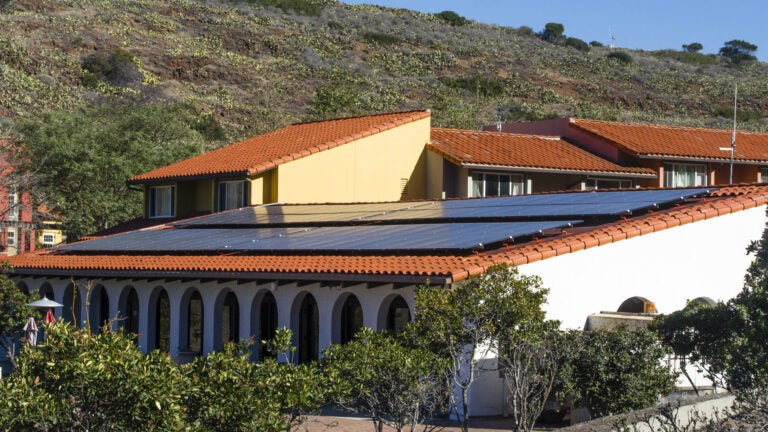
Eighty-eight solar panels convert sunshine into electricity for the Wrigley Center’s dormitory and kitchen facilities. (Photo/Karl Huggins)
Solar energy system up and running at USC’s Catalina Island facility
The installation and launch of a solar energy system at USC Wrigley Marine Science Center marks a significant step in the university’s efforts to boost sustainability
At its Catalina Island home 22 miles off the coast of Southern California, the USC Wrigley Marine Science Center basks in bright sunshine for more than two-thirds of the year on average. The center — a focal point for USC’s marine and environmental research and education efforts — recently began harvesting that sunshine to help support its operations and overall goal of a sustainable campus.
The March 17 activation of a newly installed solar energy system marked an important milestone in the university’s march toward becoming a more sustainable campus.
“It’s a demonstration of how you can harness, but not alter, natural resources to achieve the dual goals of teaching and practicing environmental science and sustainability,” said Roberta Marinelli, director of the USC Wrigley Institute for Environmental Studies.
The 23 kW solar energy system — a donation from Helix Electric, a national electrical contractor — includes 88 solar panels generating an average of about 98 kilowatt hours of electricity per day, or nearly 3 megawatt hours each month.
The energy output covers about 20 percent of the electrical burden for the center’s dormitory and kitchen and dining facilities, marking a major energy offset for the site.
The cost of island living
Catalina Island comprises 75 square miles of land surrounded by the Pacific Ocean. Isolation from the mainland presents significant challenges, particularly for energy and water resources.
The majority of the island’s electricity needs are supplied through Southern California Edison’s Pebbly Beach Generating Station, which runs on diesel fuel. Shipping the fuel from the mainland is expensive, and while SCE has taken steps to limit pollution from the station, it remains an issue by its very nature of burning fossil fuels.
An array of 88 solar panels converts sunshine into electricity for the Wrigley Center’s dormitory and kitchen facilities.
At the same time (and despite the rather ironic ubiquity of ocean water), fresh water for drinking, hygiene and other uses is scarce. Residents are limited to 25 gallons per day per person.
“The production of energy and water, both major concerns for sustainability, are often coupled,” Marinelli said. “For example, in [the Catalina Island city of] Avalon, you can desalinate salt water and make fresh water, but it takes a huge amount of energy to do it.”
On the other hand, water often is used to cool power plants or to generate power through hydroelectric facilities.
Converting sunshine to electricity helps break the interdependence of the two resources.
When you install solar you begin to decouple the water-energy nexus.
Roberta Marinelli
“When you install solar,” Marinelli said, “you begin to decouple the water-energy nexus.”
The Wrigley Center also is working to develop systems to reclaim water and to capture rain water for landscaping and other purposes where appropriate, she added.
“So here’s an effort where you’re not using energy to create water and you’re not using water to create energy — you’re getting both of them through different means.”
An energetic partnership
The installation of the new solar energy system was a collaboration involving the Wrigley Institute, USC Capital Construction and Helix Electric. The latter organization, in conjunction with solar equipment manufacturers SolarWorld Americas Inc. and SMA America, donated the system components and installation.
“We saw that both USC and Helix had this desire to explore more sustainable, renewable energy options, especially for the Wrigley Marine Science Center since it’s on Catalina Island,” said Boris Shekhter MBA ’13, president at Helix Electric. “Being a remote place, renewable energy is so critical.
“It’s a chance for USC to demonstrate the value of renewable energy technology out on Catalina, where this technology can make a real difference,” added Shekhter, who graduated from the USC Marshall School of Business.
David Brian, director of pre-construction for renewable energy at Helix Electric, managed the planning stages of the project for the company. He noted the importance of preparing for long-term operation and worked with USC to ensure that the older building, particularly the roof receiving the solar panels, was ready for the installation.
“I know those buildings have been there quite a long time,” Brian said. “The USC team was able to get the roof situated to where you’re not going to have any issues and that system is going to be producing well for the next 30 years or more.”
Research and education benefits
The system also has remote monitoring, according to Jerome Jontry, senior project manager in USC Capital Construction. An interactive display will be available at the Wrigley Center and one day could be linked to other locations on campus.
“With the data collected from the system, you can really judge the efficacy of solar out there [on the island],” said Jontry, who oversaw the project for USC. “This is a research institution, and the data from the facility is key to understanding the true benefits of solar. This system will be able to provide that.”
Jontry said the monitoring system is also intended to be used as well for educational purposes, something Shekhter values highly.
“Our thinking is this: If we can install a lot of renewable energy and get people excited about it, that’s the kind of education and outreach we want to participate in,” Shekhter said. “The younger generation is increasingly more aware of sustainable energy, and we think educating is relatively easy. It’s mostly about exposing them to the options and engaging them in the process.
“I’m glad that USC is moving this way for the benefit of renewable energy and the future.”
